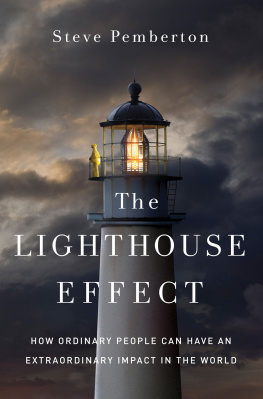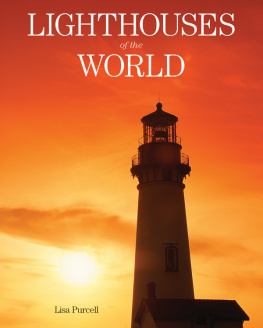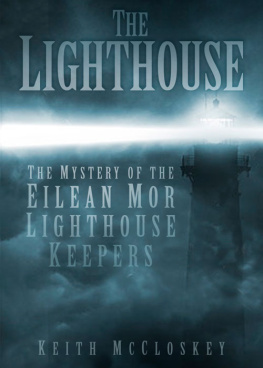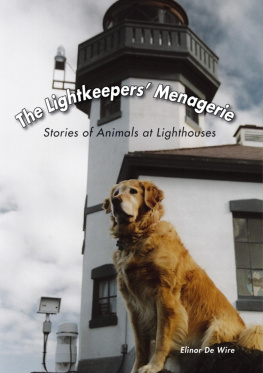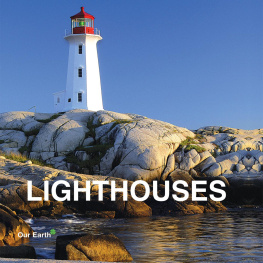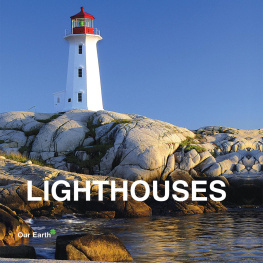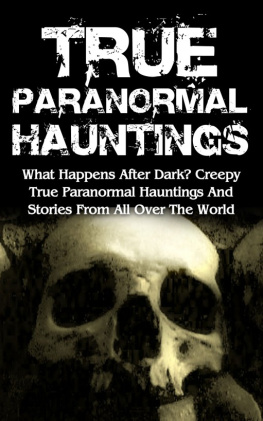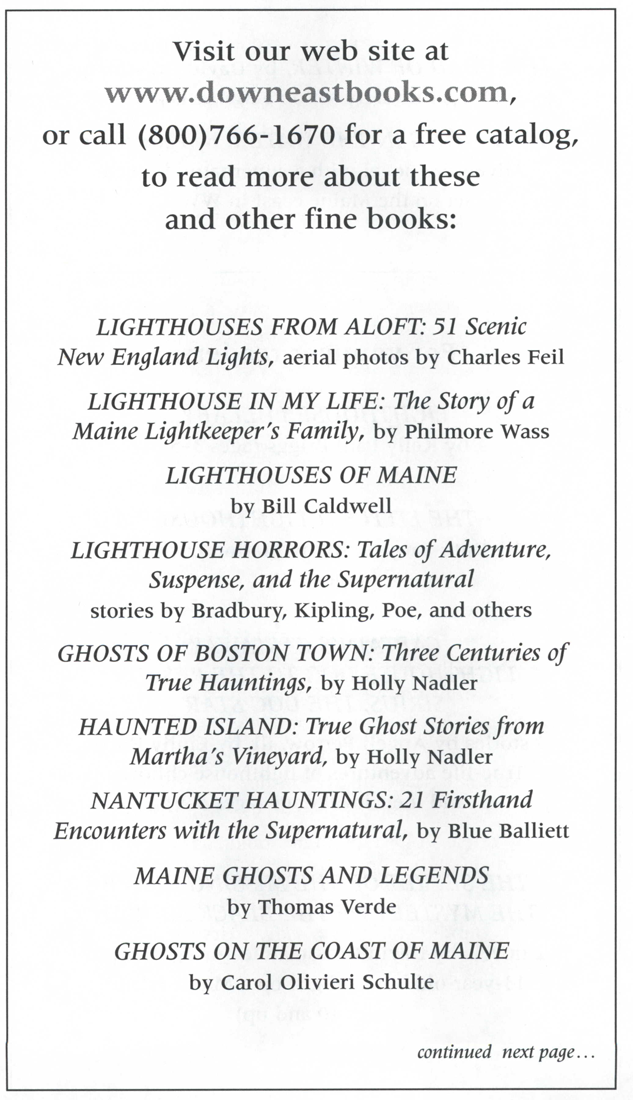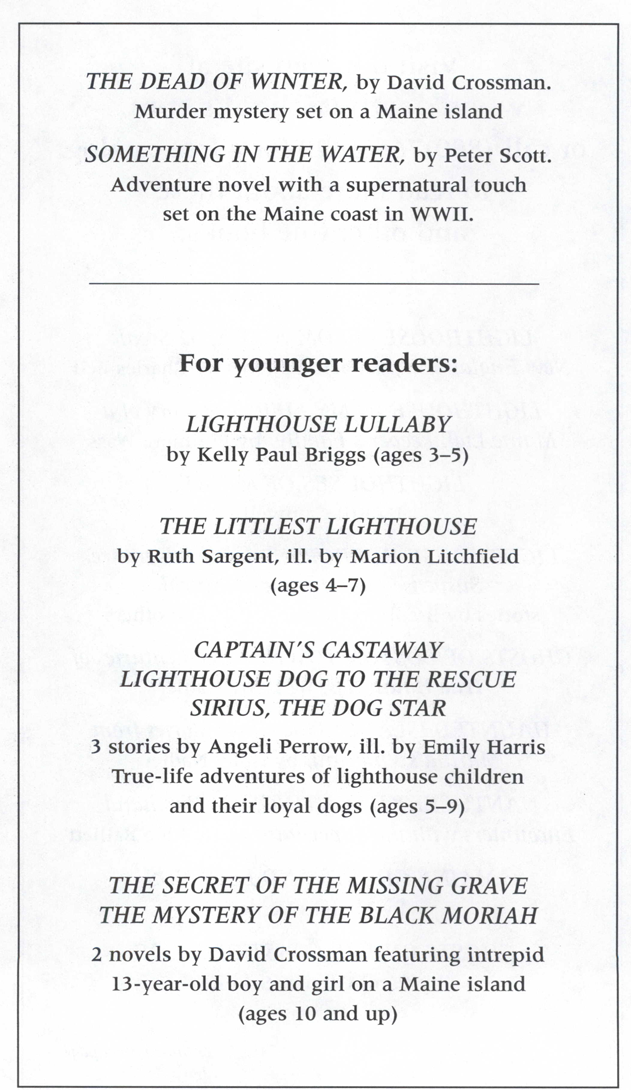CONTRIBUTORS
Rick Hautala has had more than twenty books published, including the million-copy international bestseller Nightstone. Nearly seventy-five of his short stories have appeared in national and international anthologies and magazines. His media tie-in novel. Poltergeist: The LegacyThe Hidden Saint was published in 1999, and four other novels came out in 2001
A graduate of the University of Maine, with a Master of Arts in Renaissance Literature, Hautala is married and lives in southern Maine with his family. He has served terms as vice president and trustee for the Horror Writers Association.
Jane Lindskold spent her summers on Chesapeake Bay, where she learned to appreciate the constancy of lighthouses. These days she lives in New Mexico, a state so dry that the tiny pond in her yard attracts migrating birds. Her more recent novels include Changer and Legends Walking.
Brendan DuBois is the award-winning author of short stories and novels. His short fiction has appeared in Playboy, Ellery Queens Mystery Magazine, Alfred Hitchcocks Mystery Magazine, Mary Higgins Clark Mystery Magazine, and numerous anthologies. He has received the Shamus Award from the Private Eye Writers of America for one of his short stories, and has been nominated three times for an Edgar Allan Poe Award by the Mystery Writers of America.
Hes also the author of the Lewis Cole mystery series. His most recent novel. Resurrection Day, is a suspense thriller that received the Sidewise Award for best alternative history novel of 1999. He lives in New Hampshire with his wife, Mona.
Ed Gorman has been called One of the most original crime writers around by Kirkus Reviews and A powerful storyteller by the Los Angeles Times. He works in horror and westerns as well as crime and writes many excellent short stories. To date there have been six Gorman collections. He is probably best known for his Sam McCain series, set in the small-town Iowa of the 1950s. He has also written a number of thrillers, including The Marilyn Tapes and Black River Falls, with the latest being The Poker Club.
Billie Sue Mosiman has published eight suspense novels, garnering an Edgar Award nomination for Night Cruise and a Stoker Award nomination for Widow. Always active as a short story writer, she has seen her work selected for various magazines and anthologies. She has also co-edited several anthologies. Her most recent work is the novel Red Moon Rising. She lives in Midway Texas.
Kristine Kathryn Rusch has been nominated for several dozen fiction awards, and her short work has been reprinted in six Years Best collections. She has published twenty novels under her own name and has sold forty-one total, including pseudonymous books. Her novels have been published in seven languages and have spent several weeks on the USA Today and Wall Street Journal bestseller lists. She has written a number of Star Trek novels with her husband, Dean Wesley Smith, and is the former editor of The Magazine of Fantasy and Science Fiction, winning a Hugo for her work there. Before that, she and Smith started and ran Pulphouse Publishing, a science fiction and mystery press in Eugene.
She lives and works on the Oregon Coast.
Matthew Costello was known primarily as a horror writer and author of bestselling computer games until the late 1990s, when he began collaborating with F. Paul Wilson on bestselling mainstream science fiction. Costello is primarily a character-driven writer. Whatever else is going on in the story, Costello is letting you know about his people.
A.J. Matthews s first novel. The White Room, was published in 2001. He is a semi-retired junior high school English teacher who lives in southern Maine with his wife and two sons. This is his first published short story and his first collaborative work with Matthew Costello. When not writing or reading, he is usually found asleep on the couch.
In her twenty-five years as a writer, editor, and publishing consultant, Janet Berliner has worked with such authors as Peter S. Beagle, David Copperfield, Michael Crichton, and Joyce Carol Oates. Among her most recent books are David Copperfields Beyond Imagination, an anthology that she created and edited, and Children of the Dusk, the final book of the Madagasacar Manifesto series, coauthored with George Guthridge. Currently Janet divides her time between Las Vegas, where she lives and works, and Grenada, West Indies, where her heart is.
Yvonne Navarro is an award-winning Chicago area novelist whose work was first published in 1984. Since then shes had twelve novels, a reference dictionary, and over seventy short stories published. Her writing has been nominated for the Bram Stoker Award several times and she won the CWIP Award for Excellence in Adult Fiction in 1997. Shes the owner of Dusty Stacks Bookstore and also studies martial arts. Sometimes shed like to chuck it all and run off to Arizona.
Nina Kiriki Hoffman has been writing for almost twenty years and has sold almost two hundred stories, two short-story collections, novels, a young-adult novel with Tad Williams, a Star Trek novel with Kristine Kathryn Rusch and Dean Wesley Smith, three R.L. Stines Ghosts of Fear Street volumes, and one Sweet Valley Junior High book. She has cats.
Thomas F. Monteleone has been a professional writer since 1972. He has published more than a hundred short stories, many of which have appeared in best-of-the-year compilations. He is the editor of six anthologies, including the highly acclaimed Borderlands series, edited with his wife, Elizabeth. Of his twenty novels. The Blood of the Lamb received the 1993 Bram Stoker Award, and the New York Times Notable Book of the Year Award. His books and stories have been translated into twelve foreign languages.
Monteleone lives in Grantham, New Hampshire.
Gary A. Braunbeck is the author of several short story collections. His first solo novel. The Indifference of Heaven, was recently released by Obsidian Books, as was his Dark Matter novel. In Hollow Houses. He lives in Columbus, Ohio, and has, to date, sold nearly two hundred short stories. His fiction, to quote Publishers Weekly, stirs the mind as it chills the marrow.
JOHN HEIFERS
Introduction
W hen America was first being explored, lighthouses played a vital role in keeping shipping lanes open on both lakes and oceans. Often a ship would only have that singular beacon of light shining across the vast distance to orient itself and avoid the dangerous cliffs, treacherous reefs, and lurking hijackers that waited to snare the unwary sailing vessel. The lighthouse keeper alone was responsible for dozens of mens lives in an evening. If he failed, the consequences would be tragic.
Because of this idea, and the fact that lighthouse keeping seems a quaint and long-abandoned career with the advent of todays modern shipping equipment and techniques, the lighthouse and its keeper have become a romanticized stereotype of man against the elements, battling the ocean and weather to bring ships safely to port. People today think of the peaceful solitude, the ocean lapping against the shore as the keeper relaxes after a hard days work, secure in the knowledge that all is well.
The truth is far different. As these lighthouses were often located on remote coastal peninsulas and small, barren islands, they required a special kind of person to man them. The men and women who kept the lights burning faced a harsh environment, isolation, and loneliness, especially during the long, dark winters. Storms lasted for days, and even weeks on end, and blizzards and endless snow cut off the lighthouse from the rest of society, leaving the keeper and his family (if he had one) without another soul to talk to for several months. Wrestling with the crude, dangerous equipment for up to twenty-four hours at a time to make sure the light stayed on was part of the job. Yes, it took a hardy breed to survive in the lighthousesometimes so hardy that they were loath to leave, even when their time was up.



